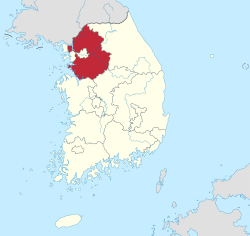
Back Gyeonggi ACE غيونغي (مقاطعة) Arabic Kyonqido Azerbaijani Gyeonggi BAN Кьонги-до Bulgarian Gyeonggi-do Catalan Gyeonggi Dô̤ CDO Gyeonggi-do CEB پارێزگای گیۆنگگی CKB Kjonggi Czech
This article needs additional citations for verification. (January 2024) |
Gyeonggi Province
경기도 | |
|---|---|
| Korean transcription(s) | |
| • Hangul | 경기도 |
| • Revised Romanization | Gyeonggi-do |
| • McCune‑Reischauer | Kyŏnggido |
 | |
| Coordinates: 37°30′N 127°15′E / 37.500°N 127.250°E | |
| Country | |
| Region | Seoul Capital |
| Capital | Suwon |
| Subdivisions | 28 cities; 3 counties |
| Government | |
| • Governor | Kim Dong-yeon (Democratic) |
| • Legislature | Gyeonggi Assembly |
| Area | |
| • Total | 10,199 km2 (3,938 sq mi) |
| • Rank | 5th |
| Population (Census 2020) | |
| • Total | 13,511,676 |
| • Rank | 1st |
| • Density | 1,327/km2 (3,440/sq mi) |
| Provincial symbols | |
| • Flower | Forsythia |
| • Tree | Ginkgo |
| • Bird | Dove |
| GDP | |
| • Total | KR₩ 547 trillion US$ 438 billion (2022) |
| ISO 3166 code | KR-41 |
| Dialect | Gyeonggi |
| Blog | Official blog |
| Website | Official website (English) |
Gyeonggi Province (Korean: 경기도; RR: Gyeonggi-do, Korean pronunciation: [kjʌ̹ŋ.ɡi.do̞]) is the most populous province in South Korea.
Seoul, the nation's largest city and capital, is in the heart of the area but has been separately administered as a provincial-level special city since 1946. Incheon, the nation's third-largest city, is on the coast of the province and has been similarly administered as a provincial-level metropolitan city since 1981. The three jurisdictions are collectively referred to as Sudogwon and cover 11,730 km2 (4,530 sq mi), with a combined population of over 26 million - amounting to over half (50.25%) of the entire population of South Korea at the 2020 census.
- ^ "2022년 지역소득(잠정)". www.kostat.go.kr. Archived from the original on January 23, 2024. Retrieved December 23, 2023.







